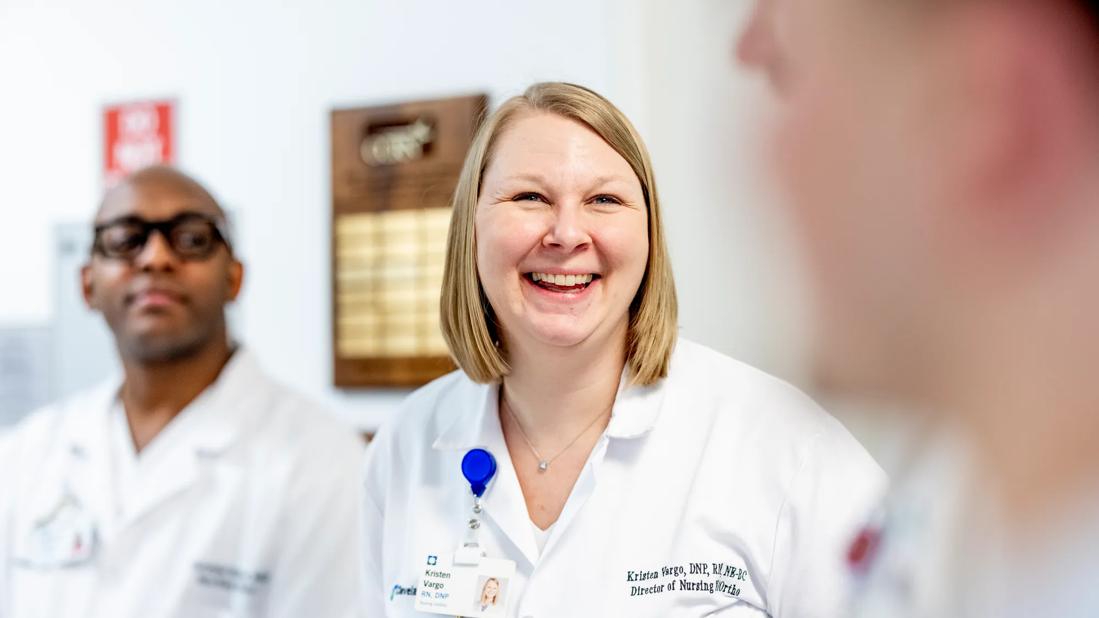Request for training builds competence, satisfaction

What if the preferred name or gender on a patient’s electronic medical record (EMR) isn’t up-to-date — or you suspect it’s not? How do you tactfully explain to a transgender man who hasn’t had transition surgery that he needs a pregnancy test before a procedure? How do you know if a transgender patient coming out of surgery should use a urinal or a bedpan?
Advertisement
Cleveland Clinic is a non-profit academic medical center. Advertising on our site helps support our mission. We do not endorse non-Cleveland Clinic products or services. Policy
Nurses in Cleveland Clinic’s Same Day Surgery unit had many questions like these as they began encountering more transgender patients due to the health system’s expanding LGBT (lesbian, gay, bisexual, transgender) services.
“We want to provide excellent, sensitive, culturally competent care, but many nurses weren’t confident that they were doing so for transgender patients,” says Kristen Vargo, MSN, RN, NE-BC, Nurse Manager of Same Day Surgery and Pediatric PACU.
Vargo and other nurses requested help from their nurse educator, Donna Voldan, BSN, RN, CAPA, who reached out to Cleveland Clinic’s Office of Diversity and Inclusion. In response, Donna Skurzak, MA, CDP, Director of Diversity and Inclusion, and Cecile Unger, MD, MPH, Director of Transgender Surgery and Medicine, hosted two training and Q&A sessions attended by nearly all Same Day Surgery nurses.
“We learned about healthcare disparities and how many transgender patients don’t seek care because they think healthcare workers won’t understand them and won’t provide the care they need,” says Vargo. “That made us think about how we can make things more welcoming and comfortable for them.”
According to Skurzak, part of that involves recognizing that almost everyone has unconscious, or unintentional, bias that affects their perception of people and behaviors toward them. For example, unconscious bias may be the reason someone inaccurately refers to a transgender woman as “him” when the appropriate pronoun is “her.”
“Not only do we need to be aware of bias, we need to be intentional about overriding it — as well as using culturally competent language to create a transgender-affirming environment,” says Skurzak.
Advertisement
According to Vargo, the biggest changes Same Day Surgery nurses have made since the training are:
Not using “Mr.” or “Ms.” “We all learned how to greet patients politely and professionally by using gender-specific titles,” says Vargo. “But that’s not always acceptable — if a patient whose sex is male doesn’t prefer to be called ‘Mr.’ for example.”
Instead, nurses have stopped using titles when greeting any patient and now simply ask “How may I help you today?”
Asking patients for their preferred name and pronouns. Nurses shouldn’t make assumptions, says Vargo. They now ask all patients “How would you like to be addressed today?” and “What pronouns do you use to define yourself?” If a patient’s EMR shows a different name and gender, nurses ask “Could your chart be under a different name?” and possibly “What name do you want in your medical record?”
“Some patients don’t necessarily want their new name or gender noted in the EMR,” says Vargo. “If they do, however, we will contact the admitting department to have the record changed.”
“Nurses had been worried about offending a patient or saying something wrong,” says Skurzak. “We introduced them to ways they can exchange information in a neutral, respectful way. Now they use that language for all patients, regardless of gender identity.”
Caregivers may not always get it right, notes Vargo. There still may be times when they use an incorrect name or pronoun, in which case, they’ll respectfully apologize.
After each training session, nurses reported significant increases in understanding transgender patients and their needs. Surveys recorded approximately 20 percent jumps in knowledge after both the first training in January 2017 and second training in April 2017.
Advertisement
“We will continue to progress, but we’ve come a long way in how we interact with our transgender patients,” says Vargo.
Same Day Surgery nurses have begun spreading their new knowledge and awareness, presenting what they’ve learned to nurses in other inpatient and surgery units. Their initial concerns also raised awareness of EMR issues, triggering a system-wide technology enhancement. Every clerical and clinical user at Cleveland Clinic now views a standard EMR header, with a patient’s preferred name and gender easily visible.
“Everyone assumes that healthcare professionals already know how to care for transgender patients,” says Skurzak. “But there’s a big learning curve, and many caregivers have had limited encounters with transgender patients and limited opportunities to provide them care.”
When unsure of how to provide the best patient experience, she adds, it’s perfectly acceptable to ask for help — just like the nurses in Same Day Surgery.
“We now have the training and resources to provide world-class care for transgender patients,” says Vargo. “Our confidence and job satisfaction have increased.”
Advertisement
Advertisement

How to create a welcoming environment and provide high-quality care for patients who are neurodivergent

Music therapists provide solace, help patients meet therapeutic goals

E-learning modules improve learning, satisfaction and more

Remote caregivers allow bedside nurses to breathe easier when out of a patient’s room

CNO offers advice for listening to patients, interacting with families and communicating effectively

Prototype leverages collaboration between nurses and nursing assistants

Nurses play key role in comprehensive lifetime treatment program

Compassionate care requires nurses to see beyond medical conditions to understand the complete patient